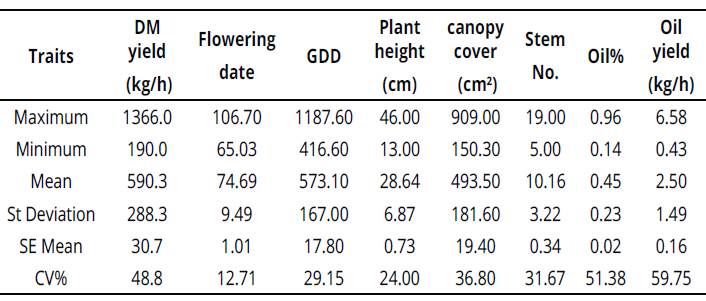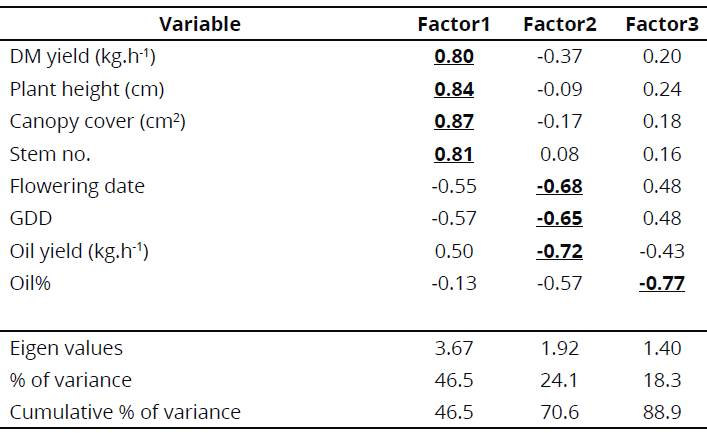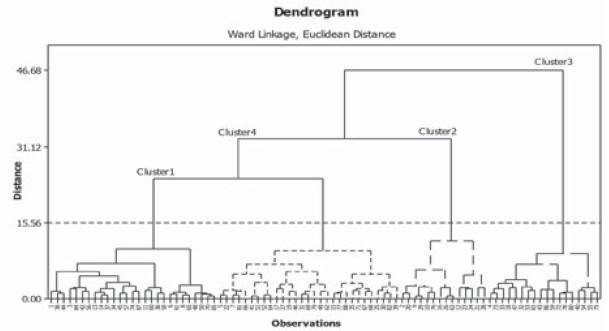Introduction
Genus of Tanacetum with name of tansy are perennial, herbaceous plants and all of its species smell like mint. This genus belongs to family Asteraceae and tribe of Anthemideae. This genus has 160 species and they are native to many regions of the Northern Hemisphere as Europe, temperate Asia, North America, and North Africa (Oberprieler, Himmelreich & Vogt, 2007). The origin of Tanacetum is southwest of Asia and Caucasus (Heywood & Humphries, 1977). Its distribution pattern in Iran, in the rangelands of Zagros and Alborz Mountains and also in North Khorasan in the northeast of Iran (Mozaffarian, 2005). The species of Tanacetum genus is a valuable medicinal plant. The flora of Iran comprises 26 species of Tanacetum, of which 12 are endemic (Mozaffarian, 2005; 2008).
The genus is rich in essential oils, bitter substances and sesquiterpene lactones (Akpulat, Tepe, Sokmen, Daferera & Polissiou, 2005). It traditionally been used as a spicy additive for food. In cosmetics and as herbal remedies, due to existence of biologically active compounds, this species is known as a good treatment for infectious disease (Nezhadali, Soleymani & Akbarpour, 2009). Some members of the genus Tanacetum has traditionally been used in balsams, cosmetics, dyes, insecticides, medicines and have been found to act as a preservatives and are used in herbal remedies. According some published study, the oils and extracts of members of the Tanacetum genus exhibit anti-inflammatory, antibacterial and antifungal (Hethelyi, Tetenyi, Danos & Koczka, 1991), and insecticidal effects (Hough & Hahn, 1992). The terpenes in the essential oil are thought to associate with the biological activity of Tanacetum. With respect to T. parthenium, many studies were related to the sesquiterpene lactone parthenolide and flavonoids, to the strong biological activity (Long, Sauleau, David, Lavaud, Cassabois, Ausseil & Massiot, 2003).
Tancetumt polycephalum is perennial or biennial species with multiple fertile and sterile stems, Covered with short hairs gray felt, 20 to 40 cm height. The time of flowering and fruiting is summer. This species belongs to Iranian Turonian and Caspian region. It is distributed in north-west of Iran, Turkey, Caucasus and north of Iraq. The achenes is cylindrical, 2 to 2.5 mm height (Mozzaffarian, 2008).
Currently, there is no comprehensive information about field evaluation of T. polycephalum genetic resources in Iran. According to the importance of this plant in Iran medicinal industry and also high potential, is necessary this plant to be domesticated as a crop plant. The aim of this study was to evaluate the genetic variation and relationship between DM yield and essential oil production in 84 populations of T. polycephalum through a multivariate analysis.
Material and methods
Plant material
In this research, 84 populations Tanacetum polycephalum (Table 1), were evaluated in the field. Seeds were provided from the Natural resource gene bank of research Institute of Forest and Rangeland, Tehran, Iran. Initially, seeds were sown in Jiffy pots in 2012. Subsequently, seedlings were transferred in the field in Alborz research station in Karaj, Iran in March 2013. Experiment was carried out in a randomized complete block design (RCBD) with three replicates. Each unit of experiment consisted of six rows with 50 cm apart each other with distance of 40 cm and length of 3 m. Data were collected for flowering date, growth degree days (GDD), stem number, plant height, dry matter (DM) yield, essential oil percentage, and essential oil yield.
Table 1 Accessions codes and origins in natural resource gene bank and their classification using cluster analysis Ward method.

Flowering date was recorded as number of days from date 21 March till first flowering emergence date per plant (Siddiqui, Oad & Jmaro, 2006). GDD were recorded using Equation 1, as follows:
Where:
GDD= Growth degree days
Tmax= Maximum daily temperature
Tmin= Minimum daily temperature
Tb = Base temperature (Physiological zero for germination). Base temperature for those species was considered as 6°C.
For extraction and measuring of essential oil, herb collected at full flowering stage, subsequently, 80 g of dried grinded material were taken and mixed with 500 ml of tap water in flask and the water was distilled for 2 h to determine essential oil as follows (Equation 2):
Essential oil yield was calculated by essential oil% x aerial biomass yield. Kg.h-1.
Statistic analysis
Collected data were analyzed for normality test. Means of 84 populations over replicate, were used for multivariate analysis. Descriptive statistics as means, standard deviation, maximum and minimum from all morphological traits, were determined. Relationships among traits were determined using correlation analysis. A stepwise regression equation was developed for essential oil yield as dependent variable and other traits as independent variables. Data were also subjected to factor analysis after varimax rotation. Genetic distance and genotype classification were determined using cluster analysis (Solouki, Mehdikhani, Zeinali & Emamjomah, 2008). All statistical analyses were conducted through MINITABTM ver16 software. To identify significant difference among treatments and statistical significance for all comparisons was made at p<0.05. Tukey's multiple range test was used to compare the mean values of treatments.
Results
Result of analysis of variance showed significance differences among populations for all morphological traits (P<0.01) (ANOVA and mean comparisons are not shown).
Descriptive statistics
Result of descriptive statistics including mean, standard deviation, standard error, maximum and minimum from all morphological traits is presented in Table 2.
Table 2 Mean, standard deviation, maximum and minimum of DM yield and other traits in populations of T. polycephalum

Results showed higher coefficient of variation for DM yield, essential oil% and oil yield, which indicates that should be possible plant breeding could improve new cultivars for both, oil% and oil yield using mass selection method in the study populations.
Correlation among morphological traits
Result of simple correlation analysis showed that there was significant positive correlation between flowering date and GDD (p<0.01). Both, flowering date and GDD, had achieved a negatively correlation with plant height, canopy cover (p<0.05) and stem number p<0.01). DM yield was positively correlated with plant height, canopy cover, stem number and oil yield (p <0.01), whereas essential oil% was negatively correlated with plant height and stem number (p <0.05). There were also positive correlations among plant height, canopy cover, stems number and essential oil yield (p<0.01) (Table 3).
Regression analysis
Results of stepwise regression in which essential oil yield were considered as dependent variable and other traits as independent variables.
Table 4, showed that essential oil%, DM yield and stems numbers, were entered in final equation with coefficient of determination (R2=88.86). These three variables accounted for 39.95, 47.75 and 1.15%, of the total variations for essential oil production, respectively (Table 4).
Factor analysis
Results of factor analysis (Table 5), showed three factors with Eigen values higher than one with 88.9% from total variations. The amount of variance explained by each factor reflects its importance in explaining the total variance of the traits under study. The first three factors accounting for 56%, 18%, and 12% variation (Table 5).
Table 5 Factor matrix after varimax rotation and total variance explained for each factor on 84 productions in T. polycephalum.

The bold and underlined data had higher Eigen values in the relevant factors.
In the first factor, traits of DM yield, plant height, canopy cover and stems number had positive loading and the first factor was regarded as productivity factor. In the second factor flowering date, GDD and oil yield had higher eigin vectors and trends of these traits were in the same direction. Therefore, this factor was named as phenology and oil yield factor. In the third factor oil% had higher Eigen vector coefficients and was named as oil content factor (Table 5).
The results of this study indicated that selection of variables for productivity factor (factor1) could enable plant breeding programs to release the desirable increasing in DM production in T. polycephalum.
Cluster analysis
According to Dendrogram of cluster analysis, (Figure 1), the 84 populations of T.polycephalum were divided into four groups by genetic distance of 15.56. According to the obtained results, cluster 1 to 4 had 27, 14, 18 and 29 accessions, respectively (Figure 1, Tables 1, 6). Results of means comparison of total average values of four clusters from all morphological traits.
Table 6 Means comparison oftraits used in classification ofthe 4 clusters

Means of each column with the same letters is not significantly different based on Duncan method (P<0.05).
Table 6, showed that cluster 1 with lower flowering date and GDD recognized as early maturity group, clusters 3 for plant height, canopy cover, stems number, DM yield and essential oil production and cluster 4, for essential oil%, had significantly higher mean values than the other groups (Table 6).
Based on the first two factor scores, we scattered the genotypes in biplot (Figure 2). The first factor was considered as productivity factor since it had higher positive Eigen vectors coefficients for DM yield, plant height, canopy cover and stems number, so genotypes in the left and right hand side of Figure 2 (cluster 2 and 3), which had achieved lower and higher productivity, respectively. As we found significant negative correlation of flowering date, GDD and oil yield with the second factor, in addition, genotypes in upper part of Figure 2 (cluster 1), had achieved lower values of these traits indicating the early maturity genotypes are coupled with lower essential oil production.
There was a good agreement among results obtained from cluster and factor analyses in scatter diagram representation of 84 genotypes based on the first and second factors.
Discussion
Result showed that there were significant positive correlation between DM yield and plant height, canopy cover, stem number and oil yield (p <0.01). These results are comparable in variability to the report by Alizadeh, Adeli & Jafari (2015), in evaluation of chamomile populations (Anthemis triumfettii (L.) DC.). Time required for flowering and GDD had the same trend in relationships with other traits. Both traits GDD had negatively correlated with plant height, canopy cover and stem number, indicating that selection of early flowering accessions led to increasing morphological traits.
Our result indicted oil% was negatively correlated with, plant height and stem number, in contrast, Adeli, Alizadeh & Jafari (2013), in two species: Matricaria recutita L. and Matricaria aurea (Loefl.) Sch.Bip., found that essential oil% was positively correlated with plant height, stem number and DM yield. In our result there was no correlation between essential oil% and maturity date, however, Adeli, Alizadeh & Jafari (2016), found negative relationships and suggested that early maturity plants had higher essential oil content. There was strong correlation between essential oil yield and essential oil%. This result was in concordance to previous results obtained by Soluki et al. (2008), in Matricaria chamomilla L., and Hamisy, Sefidkon, Nasri & Lebaschi (2012), in Tanacetum parthenium (L.) Sch.Bip.
Results of stepwise regression in which essential oil yield were considered as dependent variable showed that essential oil%, DM yield and stems number were entered in final equation. Similar to our result, Fulton, Clark & Fulton (2001), found higher pyrethrins (one of essential oil components) yield of Tanacetum cinerariifolium (Trevir.) Sch.Bip. They also found that DM yield was positively correlated with stem number. They found flowering stem number is one of the yield component in T. polycephalum, which increased with plant density. Our results also confirmed the result of Golparvar, Ghasemi & Karimi (2011), in determination of the effective traits on essential oil% in German chamomile (Matricaria chamomilla L.) populations. They found positive and significant relation of dry flower yield and essential Oil%.
Results of multivariate statistical analysis in 8 traits in 84 accessions of T. polycephalum using PCA and Ward cluster, indicating that DM yield, plant height, canopy cover and stems number accounted for 56% of total variation and had positive loading and the first factor was regarded as productivity factor. In the second factor flowering date, GDD and oil yield had higher were accounted for 18% of total variation. Similar to our result, Kazemi, Sonboli, Zare & Kazempour (2014), using cluster analysis in Tanacetum aureum, T. oligocephalum and T. heimerlii well differentiated the accessions into separate species. Similarly, Alizadeh & Jafari (2016), in cluster analysis for grouping of the accession of Anthemis triumfettii (L.) DC., Anthemis tinctoria L. , Anthemis haussknechtii Boiss. & Reut. and Anthemis pseudocotula Boiss. well separated accession based on aerial biomass yield, morphological traits and maturity.
Conclusion
There was strong correlation between essential oil yield and essential oil%. Similarly, essential oil yield had positive and significant correlations with all of traits except phenological traits. Analysis of correlation and regression indicates that selection should be focused on high aerial biomass yield and essential oil%, plant height and high flower number. Regarding to cluster analysis, it was cleared that lower value of flowering time and GDD were observed in genotypes of cluster1. Therefore, populations of this cluster were considered as early maturity population compare with other populations. Populations in cluster 3 had higher DM yield, stem number, canopy cover and essential oil production than the other clusters. It was concluded that population of cluster 3 are capable to breeding improved new cultivars and should be focused on selection higher aerial biomass yield, plant height, flower number, essential oil%, coupled with early flowering date.




















